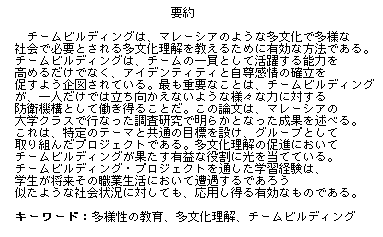|
Abstract
Team building constitutes a promising way of instilling multicultural understanding, necessary in a diverse society like Malaysia. Team building is designed to confirm a person's sense of identity and self-esteem, besides improving the ability to work in teams. Most importantly, team building can serve as a defence mechanism against forces that group members might not be able to resist on their own. This paper attempts to share findings gathered in a research conducted within a Malaysian university classroom setting. This is done through group projects undertaking specific themes and common goals. It will highlight the benefits of team building specifically in promoting multicultural understanding. The learning experience through team building projects can be relevant and transferable to similar social situations, which the students will encounter, in their future careers.
Keywords: diversity education, multicultural understanding, team building
|



